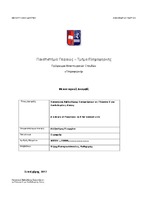Κατασκευή βιβλιοθήκης συναρτήσεων σε γλώσσα C για συνδεδεμένες λίστες
A library of functions in C for linked lists

View/
Keywords
Βάσεις δεδομένων ; Γλώσσα CAbstract
Linked list is one of the fundamental data structures in C. Knowledge of linked lists is must for C programmers. This work explains the fundamentals of linked lists with a library of C functions. Linked lists are a data structure which you may want to use in real programs. The strengths and weaknesses of linked lists give an appreciation of the some of the time, space, and code issues which are useful to thinking about any data structures in general. Linked list is a dynamic data structure whose length can be increased or decreased at run time. In a linked list the elements (or nodes) may be kept at any location. Linked lists are preferred mostly when you don’t know the volume of data to be stored. Linked lists are among the simplest and most common data structures. They can be used to implement several other common abstract data types, including lists (the abstract data type), stacks, queues, associative arrays, and S-expressions, though it is not uncommon to implement the other data structures directly without using a list as the basis of implementation .For example, in an employee management system, one cannot use arrays as they are of fixed length while any number of new employees can join. In scenarios like these, linked lists are used as their capacity can be increased (or decreased) at run time.


